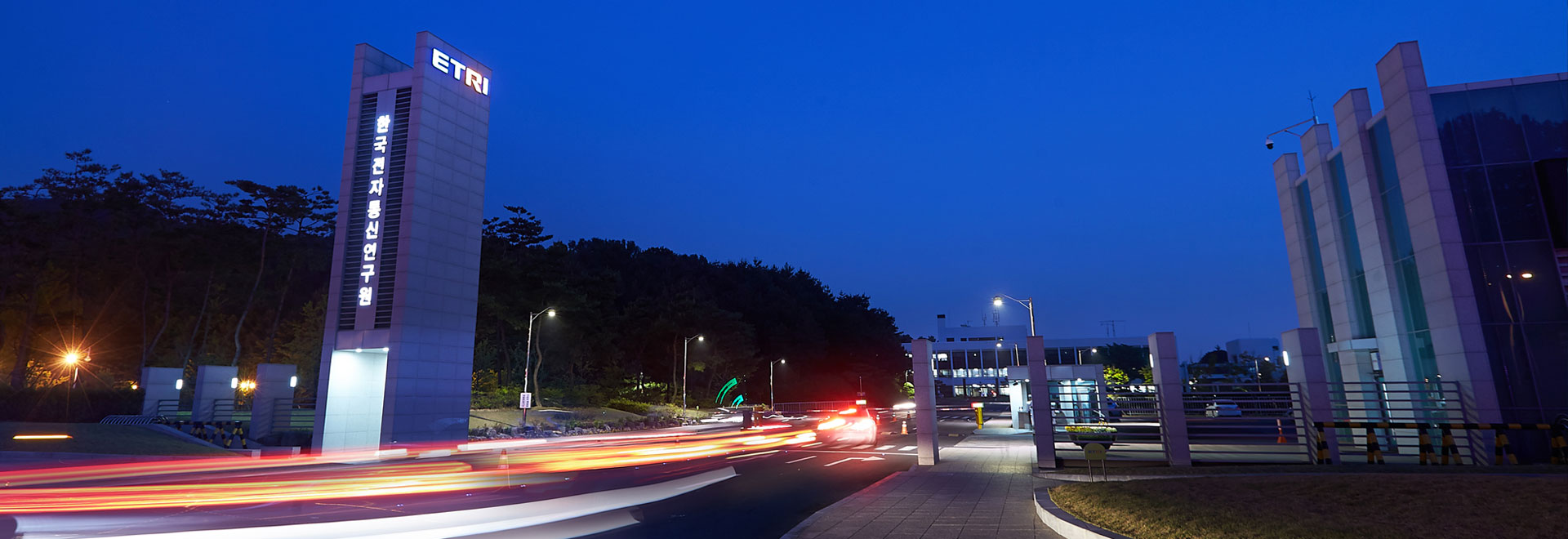
NEWS 1
World’s first inter-continental network connection demonstration between Korea and EU using 5G cellular and satellite multi-connection networks
- Developing the technologies of expanding the 5G services through the ETRI and
EU international joint research
- Showcased the enabling technologies that help expanding the 5G service coverage
into the sea or mountainous area
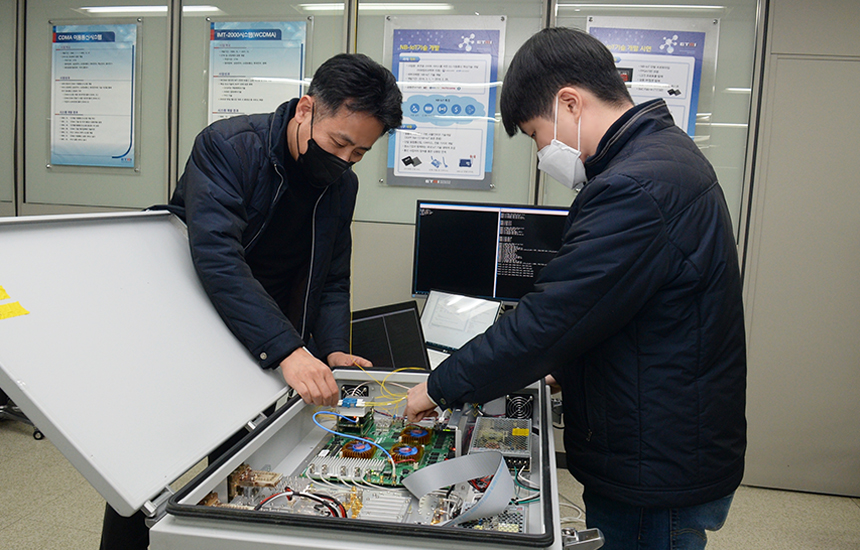
ETRI has developed the 5G technologies which can provide seamless communication services in some remote/maritime areas or in case of disaster. ETRI has successfully demonstrated some 5G services between ETRI and the French Institute of Electronic Information Technology (CEA-Leti1)) after establishing a 5G cellular and satellite multi-connectivity network through the International joint research with the European Union (EU).
The 5G cellular-satellite multi-connectivity network utilizes a 5G communication network and satellite communication network together. When a user device is connected to the 5G network and satellite communication network simultaneously, you can keep the communication service through the satellite when the cellular network is not available or vice versa.
The satellite can connect a hub or earth station and a user terminal on the ground at very high altitudes, e.g. 36,000 km for a geostationary satellite. Thus, it has a very wide service range compared to the terrestrial 5G networks. Therefore, it can be utilized under some disaster situations, such as forest fires and earthquakes, and it can be also useful in the maritime area.
ETRI has established the 5G cellular-satellite multi-connectivity testbed through 3 years’ International joint research. The research team used the testbed for the final proof-of-concept demonstration in October, 2021 and proved the merits of service continuity and availability of the multi-connectivity network.
In the final demonstration, some key services like 8K video streaming, VR online gaming, and 360 degree live webcam had been tested and all of them were successful. The research team will continue to enhance the multi-connectivity network technologies so that they can be used in the real life for more convenient communication everywhere and anytime.
1) French Atomic Energy Agency (CEA) affiliated research institute. (Laboratoire d`Electronique et de Technologie de l`Information)
Heesang Jung, Principal Researcher,
Director, Moving Wireless Network Research Section
(+82-42-860-6115, hschung@etri.re.kr)
NEWS 2
Automatic design a System-on-Chip by just click
- Securing a Key technology for the development of the world’s best ultra-low-power RISC-V processor
- Power savings of up to 35%, even college students can design their own SoC conveniently and quickly
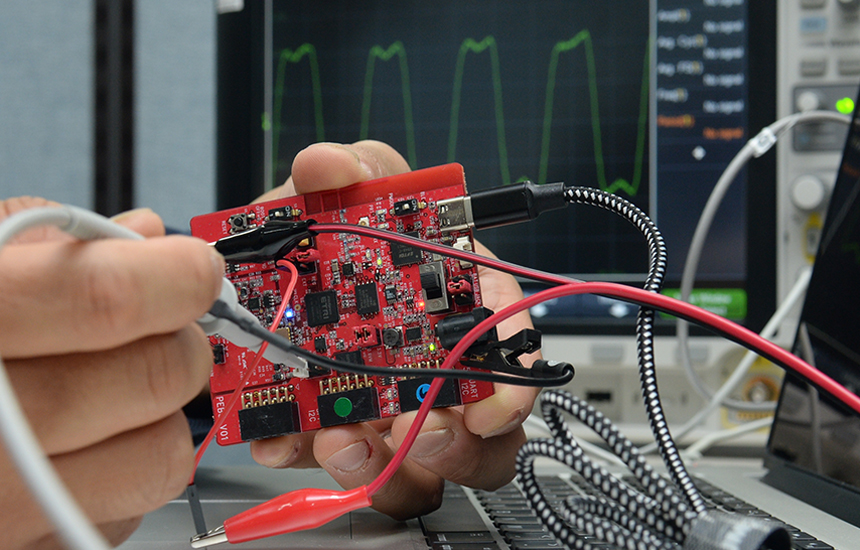
ETRI has developed RISK-V eXpress (RVX). The RVX automatically generates Verilog RTL code, FPGA prototypes, and an SDK for a target ultra-low power SoC, using a highlevel description written in XML for the IPs to be integrated into the SoC as input. It is expected to be of great help in enhancing the competitiveness of the domestic semiconductor industry and creating its ecosystem.
Currently, about 90% of IoT/wearable semiconductor chips use ARM’s CPU. If ARM’s CPU is used, modifying a design is nearly impossible and there is a burden of royalty. Therefore, CPU manufacturers and designers are paying close attention to RISC-V-based chips.
RVX developed by ETRI uses RISC-V, and its CPU structure and design assets (IP) are made public as open-source. Therefore, structural change and design can be done without the burden of royalties or restrictions. Moreover, it is possible to design a semiconductor conveniently by pressing the design button after selecting an IP suitable for the target performance. Therefore, even small and medium fabless companies or startups can quickly develop competitive products without sufficient design know-how.
Also, ultra-low-power technology specialized in the IoT/wearable field is applied to this platform, promising higher usability. Power consumption is saved by about 35% using the TEI(temperature effect inversion) phenomenon. Actually, the chip developed through the RVX platform operated an IoT application with only 0.48V while it normally operates at 0.7V voltage, demonstrating world-class ultra-low-power performance.
In the future, the research team plans to continue follow-up research to strengthen the intelligent edge semiconductor ecosystem by localizing related equipment and combining it with human body communication and artificial intelligence accelerators after enhancing semiconductor design technology.
Jae-Jin Lee, Principal Researcher,
AI Compact SoC Research Section
(+82-42-860-1712, ceicarus@etri.re.kr)
NEWS 3
Applying tactile tone system
to performances for the hearing-impaired
- Feel the melody of Daegeum (Korean traditional woodwind instrument)
without hearing a sound by wearing gloves.
- Link with Korean traditional music performances in real-time, eliminate the barrier of disability with ICT
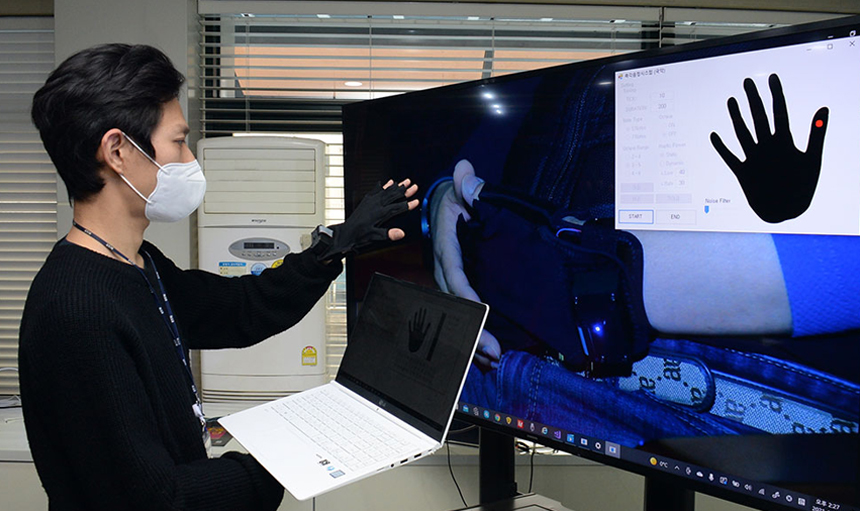
ETRI introduced a technology which delivers the melodypitch of Korean traditional music instruments to the hearing-impaired audience in real-time using the ‘tactile tone system’ developed in 2020. ‘Ieumpungryu’, a Korean traditional music performance for the hearing-impaired, was designed for the first time in Korea so that they can enjoy live performances of Korean traditional music through visual and tactile senses even if they cannot hear sound. All the played songs were provided with sign language to deliver emotion, commentary, and subtitles.
The tactile tone system applied to “Ieumpungryu” is a user interface (UI) technology which extracts frequency signals of sound from auditory information such as music or sound, converts them into tactile patterns to deliver them to the skin through devices. When you wear gloves on which this technology is applied, you can feel the musical notes change with your fingers.
ETRI has optimized the existing system by changing the existing tactile pattern of the tactile tone system from the Western scale to that of Korean traditional music and by expanding the range of sound to match it to the instrument’s characteristics for real-time linkage with traditional music performances. Moreover, a vest developed by B-Haptics, a domestic company, was used along with the gloves to which the ETRI tactile tone system is applied for the hearing-impaired to feel the rhythm with the whole body during a performance.
This performance focused on the Daegeum among Korean musical instruments, so the audience could experience the subtle changes in melody of the Daegeum through the touch of their finger. Of the total of 7 songs, 4 songs, which include Daegeum in the performance, were provided after being linked to the system. In particular, the change in notes could be felt most realistically in the Kimdongjinryu Daegeumsanjo, a solo performance of Daegeum.
In the future, the research team plans to continue research on improving the perfection of tactile actuator and devices. It also plans to expand the accomplishment of the tactile tone system even more so that the public can experience it in the fields of listening to music and learning as well as the development of educational content.
Sungyong Shin, Senior Researcher,
Human Enhancement & Assistive Technology Research Section
(+82-42-860-6414, seneru@etri.re.kr)
NEWS 4
Inventing AI Semiconductor System Capable of
5,000 trillion computing power per second
- Equipped with high-performance, low-power Korean AI semiconductors, improved
the computational performance by 4 times and the power efficiency by 7 times
- Used for large-scale AI services such as autonomous vehicles, cloud, and data centers
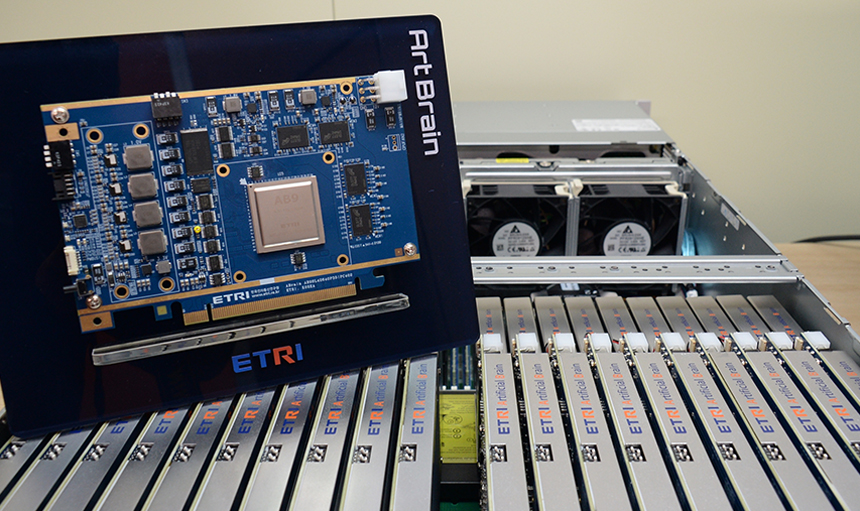
ETRI has developed an AI semiconductor system which is capable of 5,000 trillion neural calculations per second based on its homegrown lineup of AI processor, AB9 (Artificial Brain 9). AB9 is an AI semiconductor chip unveiled last year. The AI semiconductor system is called ArtBrain-K. It is designed for high-performance servers such as Hyperscale AI cloud data centers as well as high-end edge AI computing systems like automated-driving vehicles.
The first prototype of ArtBrain-K has a shape of a rack-scale server composed of 8 server nodes. One node is equipped with 20 NPU boards with built-in Neural computing AI semiconductor, the AB9. High-density integration of over a hundred of NPU boards into a single rack is the key for accomplishing high-performance servers with high energy efficiency. The popular GPU boards, which are often used for AI processing accelerators these days, are usually ’bulky’, resulting in only 6-7 units in a single server node while consuming very high power. High power consumption is due to the architectural limitation1) inherent in most GPU semiconductors. On the other hand, the NPU board developed by the research team, has a compact size with very low power consumption thanks to AB9’s novel ’super-parallel systolic tensor architecture’ optimized for parallel neural computing.
A single rack delivers the performance reaching 5 petaflops, which is 5,000 trillion neural operations per second. Compared to the existing GPU-based AI server, it has about 4x neural performance with 7x energy reduction. Its target applications would be AI applications requiring huge neural computing capability such as Hyperscale AI, a transformer-type artificial intelligence models.
The research team has already finished the transfer of semiconductor chip technology to several AI and semiconductor companies. The semiconductor design group now plans to apply their next-generation super-fast neural semiconductor architecture to automated-driving AI processor as well as Hyperscale AI’s training and inference machine.
1)The target application of GPU has been a graphics applications from its birth meaning that its baseline architecture is for graphics processing, not AI. This incurs inferior computational efficiency caused by the architectural unconformity.
Jinho Han, Principal Researcher,
AI Processor Research Section
(+82-42-860-6558, soc@etri.re.kr)